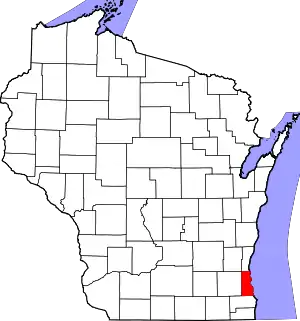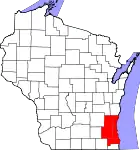West Milwaukee, Wisconsin
West Milwaukee is a village in Milwaukee County, Wisconsin, United States, which is located in the center of the county approximately a mile south of Miller Park. The population was 4,206 at the 2010 census.
West Milwaukee, Wisconsin | |
|---|---|
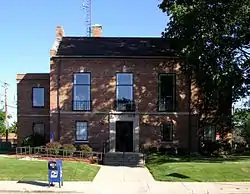 Village Hall and Police Station | |
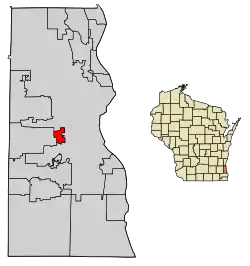 Location of West Milwaukee in Milwaukee County, Wisconsin. | |
| Coordinates: 43°0′52″N 87°58′24″W | |
| Country | |
| State | |
| County | Milwaukee |
| Area | |
| • Total | 1.12 sq mi (2.90 km2) |
| • Land | 1.12 sq mi (2.90 km2) |
| • Water | 0.00 sq mi (0.00 km2) |
| Elevation | 653 ft (199 m) |
| Population | |
| • Total | 4,206 |
| • Estimate (2019)[4] | 4,096 |
| • Density | 3,660.41/sq mi (1,413.76/km2) |
| Time zone | UTC-6 (Central (CST)) |
| • Summer (DST) | UTC-5 (CDT) |
| Area code(s) | 414 |
| FIPS code | 55-85875[5] |
| GNIS feature ID | 1576537[2] |
| Website | westmilwaukee |
Geography
West Milwaukee is located at 43°0′52″N 87°58′24″W (43.014564, -87.973469).[6]
According to the United States Census Bureau, the village has a total area of 1.12 square miles (2.90 km2), all of it land.[7]
Neighborhoods
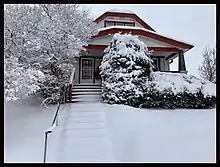
West Milwaukee consists of six neighborhoods, separated into subdivisions: Brew Manor (South 56th Street to South 54th Street, National Avenue to Beloit Road); Hillview (South 55th Street to South 51st Street, National Avenue to Burnham Street); Red Brae (South 50th Street to South 46th Street, National Avenue to Greenfield Avenue and Beloit Road); American Park (South 46th Street to Westchester Street, National Avenue to Greenfield Avenue); Juneau Heights (South 44th Street to Westgrand Lane); and Cary Park (South 40th Street to South 38th Street, National Avenue to Greenfield Avenue).
Most of American Park, Juneau Heights, and Cary Park were demolished during the 1960s and 1970s when the failed Stadium Freeway was planned.
Demographics
| Historical population | |||
|---|---|---|---|
| Census | Pop. | %± | |
| 1910 | 1,458 | — | |
| 1920 | 2,101 | 44.1% | |
| 1930 | 4,168 | 98.4% | |
| 1940 | 5,010 | 20.2% | |
| 1950 | 5,429 | 8.4% | |
| 1960 | 5,043 | −7.1% | |
| 1970 | 4,405 | −12.7% | |
| 1980 | 3,535 | −19.8% | |
| 1990 | 3,973 | 12.4% | |
| 2000 | 4,201 | 5.7% | |
| 2010 | 4,206 | 0.1% | |
| 2019 (est.) | 4,096 | [4] | −2.6% |
| U.S. Decennial Census[8] | |||
2010 census
As of the census[3] of 2010, there were 4,206 people, 1,979 households, and 856 families living in the village. The population density was 3,755.4 inhabitants per square mile (1,450.0/km2). There were 2,145 housing units at an average density of 1,915.2 per square mile (739.5/km2). The racial makeup of the village was 69.4% White, 10.2% African American, 0.8% Native American, 3.2% Asian, 12.1% from other races, and 4.3% from two or more races. Hispanic or Latino of any race were 25.4% of the population.
There were 1,979 households, of which 25.7% had children under the age of 18 living with them, 25.7% were married couples living together, 12.5% had a female householder with no husband present, 5.1% had a male householder with no wife present, and 56.7% were non-families. 45.6% of all households were made up of individuals, and 9.3% had someone living alone who was 65 years of age or older. The average household size was 2.12 and the average family size was 3.14.
The median age in the village was 34.7 years. 22.3% of residents were under the age of 18; 8.8% were between the ages of 18 and 24; 32.8% were from 25 to 44; 26.4% were from 45 to 64; and 9.6% were 65 years of age or older. The gender makeup of the village was 52.0% male and 48.0% female.
2000 census
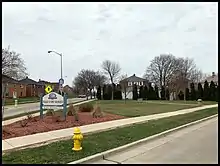
As of the census[5] of 2000, there were 4,201 people, 2,059 households, and 891 families living in the village. The population density was 3,722.0 people per square mile (1,435.4/km2). There were 2,197 housing units at an average density of 1,946.5 per square mile (750.7/km2). The racial makeup of the village was 83.58% White, 3.50% African American, 1.55% Native American, 2.55% Asian, 0.07% Pacific Islander, 5.86% from other races, and 2.90% from two or more races. Hispanic or Latino of any race were 12.00% of the population.
There were 2,059 households, out of which 22.0% had children under the age of 18 living with them, 27.5% were married couples living together, 10.5% had a female householder with no husband present, and 56.7% were non-families. 46.1% of all households were made up of individuals, and 13.4% had someone living alone who was 65 years of age or older. The average household size was 2.03 and the average family size was 2.96.
In the village, the population was spread out, with 20.8% under the age of 18, 10.3% from 18 to 24, 34.8% from 25 to 44, 20.2% from 45 to 64, and 13.9% who were 65 years of age or older. The median age was 36 years. For every 100 females, there were 103.7 males. For every 100 females age 18 and over, there were 103.8 males.
The median income for a household in the village was $35,250, and the median income for a family was $43,036. Males had a median income of $34,135 versus $23,234 for females. The per capita income for the village was $18,396. About 7.5% of families and 11.6% of the population were below the poverty line, including 9.1% of those under age 18 and 23.0% of those age 65 or over.
Property Taxes
as of 2018, Wisconsin had some of the highest property taxes in the country. The state's average effective property tax rate is 1.96%, (median real estate taxes paid: $3,257) the ninth highest average of any state in the U.S.[9] As of 2016 West Milwaukee was the ninth highest taxed ($32.38 per $1000 of assessed value) municipality in the state of Wisconsin.[10]
Street parking fees
The Village of West Milwaukee does not allow overnight parking without the purchase of a parking permit: "No vehicles shall park on the streets in the Village Of West Milwaukee between the hours of 3:00 a.m. and 6:00 a.m. without a parking permit."[11]
- The parking fees
- One month $12.00 +$0.67 tax = $12.67
- One Year $100.00 + $5.60 tax = $105.60
- Quarter Year $30.00 = $1.68 tax = $31.68
- Half Year $55.00 + $3.08 tax = $58.08[12]
Education
West Milwaukee is served by the West Allis – West Milwaukee School District. Schools within the village's boundaries include:[13]
- Pershing Elementary School
- West Milwaukee Intermediate School (formerly West Milwaukee High School)
West Milwaukee also has one private school:[13]
- Cristo Rey Jesuit High School (formerly St. Florian's Parish School)
Recreation
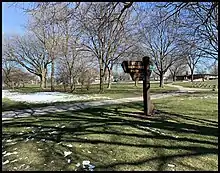
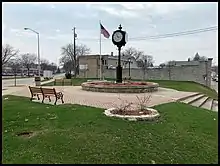
West Milwaukee has three parks: West Milwaukee Park, Centennial Park and Lions Park.[14] West Milwaukee park has a walking or jogging track, a wading pool, a children's play center and two baseball diamonds.
The village is also within walking distance of Miller Park and the Hank Aaron State Trail.
References
- "2019 U.S. Gazetteer Files". United States Census Bureau. Retrieved August 7, 2020.
- "US Board on Geographic Names". United States Geological Survey. 2007-10-25. Retrieved 2008-01-31.
- "U.S. Census website". United States Census Bureau. Retrieved 2012-11-18.
- "Population and Housing Unit Estimates". United States Census Bureau. May 24, 2020. Retrieved May 27, 2020.
- "U.S. Census website". United States Census Bureau. Retrieved 2008-01-31.
- "US Gazetteer files: 2010, 2000, and 1990". United States Census Bureau. 2011-02-12. Retrieved 2011-04-23.
- "US Gazetteer files 2010". United States Census Bureau. Retrieved 2012-11-18.
- "Census of Population and Housing". Census.gov. Retrieved June 4, 2015.
- Olya, Gabrielle. "States With the Highest Property Taxes". Yahoo Finance. Yahoo. Retrieved 16 March 2019.
- Anderson, Scott. "Tax Rates: Every Wisconsin City and Village Ranked". Patch. Patch Media. Retrieved 16 March 2019.
- "Parking Information:". westmilwaukee. Village of West Milwaukee. Retrieved 14 April 2019.
- "Village of West Milwaukee Police Department" (PDF). westmilwaukee. village of West Milwaukee. Retrieved 14 April 2019.
- "Schools". www.westmilwaukee.org. Retrieved 2016-02-13.
- "West Milwaukee Park". westmilwaukee. Village Of West Milwaukee. Retrieved 14 April 2019.
